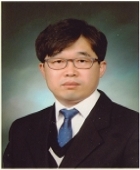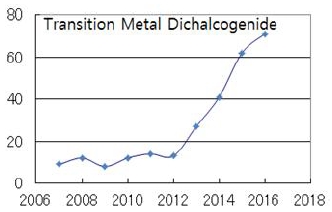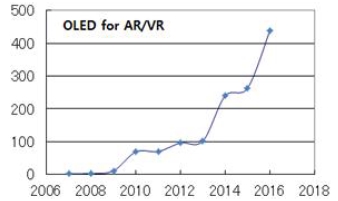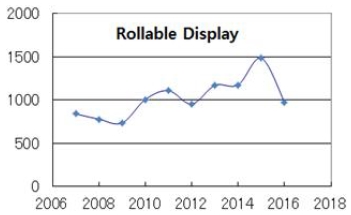
Display Manufacturing and Application Technology in the Fourth Industrial Revolution
Copyright ⓒ 2018 The Digital Contents Society
This is an Open Access article distributed under the terms of the Creative Commons Attribution Non-CommercialLicense(http://creativecommons.org/licenses/by-nc/3.0/) which permits unrestricted non-commercial use, distribution, and reproduction in any medium, provided the original work is properly cited.

Abstract
In recent years, in an environment where the Internet can be freely used anywhere, the use of small-sized displays is rapidly increasing, and accordingly, the number of display-related patent applications is increasing. We examined the display application technology through patent application analysis. In this study, we investigated the emerging technology as a Fourth Industrial Revolution technology in the display field to predict the direction of the technology development by examining the patent application trends in the core manufacturing technologies that are the recent issues in the display industry. In particular, we selected original technologies that can be applied to OLEDs and micro LEDs, and examined patent application trends and current directions. This paper reports the trends in manufacturing and applications of display technology according to patent applications.
초록
최근 인터넷을 어디서나 자유롭게 사용할 수 있는 환경이 됨에 따라 소형디스플레이가 사용이 급증하고 있고, 이에 따른 디스플레이 관련 특허출원이 증가하고 있다. 본 연구에서는 특허출원 분석을 통해 디스플레이 적용 기술을 연구하며, 디스플레이 분야에서 4차 산업시대의 기술로 떠오르는 기술을 살펴보고, 디스플레이 중심의 핵심 제조 기술에 대한 특허 출원 동향을 살펴봄으로써 기술 개발 방향을 제시한다. 특히, OLED 및 초소형 LED에 적용 할 수 있는 원천 기술을 선정하고, 특허 출원 동향 및 연구 방향을 제시한다. 본 연구에서는 특허출원을 분석하여 디스플레이 제조 및 활용에 관하여 알아본다.
Keywords:
Display, Micro LED, Transition Metal Dichalcogenide, OLED, QLED, MEMS-IGZO, Patent application, Fourth industrial revolution키워드:
디스플레이, 마이크로 LED, 천이 금속 Dichalcogenide, OLED, QLED, MEMS-IGZO, 특허 출원, 4차 산업혁명Ⅰ. Introduction
The display industry is a national key industry with a large effect on front-to-back relationships, and it is an important technology field to lead the market by securing technological competitiveness on the basis of changes in market trends. In particular, equipment investment is a large-scale device industry. If trend forecasts are missed or core technologies are delayed, investment will fail and it can reduce competitiveness between countries. Korea has selected 13 display products as its main products. In particular, it selected organic light emitting diodes (OLEDs) and micro LEDs (the next generation display) as the 12 new industries [1].
Display technology began with the development of cathode-ray tube (CRT) monitors in the 1950s, and has developed into plasma display panels (PDPs) and liquid crystal displays (LCDs). OLEDs and micro LEDs can be applied to wearable equipment because it can realize high brightness and high resolution in terms of image quality; they are also flexible and can be used as bi-directional devices by adding various sensors such as pressure sensors or fingerprint recognition sensors. OLED is a self-luminous display technology that can display colors without using a separate light source by using organic materials. It is structurally suitable for implementing a flexible display because a backlight and a liquid crystal are not required, thereby reducing the product thickness. Micro LEDs, which can replace OLEDs, can emit light in a self-luminous manner at a level of 5 to 100 µm. In addition, the reaction speed is high, the power consumption is low, and the use of inorganic materials is advantageous in that no sealing process is required to prevent oxidation [2].
On the other hand, patent-based future prediction methodologies are being actively used to analyze patent information and predict future promising technologies and search for products that will appear in the future [3]. The patent-based future prediction method is based on the general idea that when a company develops a technology, it will seek to prevent competitors from entering the market by obtaining a patent right, which is an exclusively exempted patent, before a product launch. In fact, before Apple launched the Siri-equipped iPhone 4, it acquired Fingerworks Inc., which had touch-recognition technology, and obtained their patent rights and applied for a large number of patents five years ago [3]. It takes approximately one to three years for a specific technology to be patented, so it is quite feasible to analyze the patent information that is currently in the application process to predict future product development trends. In this study, we examined the emerging display technology as a Fourth Industrial Revolution technology to predict the direction of the technology development by examining the patent application trends on the core manufacturing technologies that are the recent issues focusing on the display industry. In particular, OLEDs and micro LEDs are attracting attention in terms of flexibility because of the development trends of wearable products. By selecting original technologies that can be applied to OLEDs and micro LEDs, we investigated patent application trends and current research directions. In addition, recently, the use of small-sized display devices has been rapidly increasing because of the environment in which users can freely use the Internet; this display application technology was examined through analysis of patent applications.
Ⅱ. Display manufacturing technology
2-1 Transition metal chalcogen compound-related displays
Transition metal dichalcogenide is a nanomaterial with a structure similar to graphene; it has an electrical band gap of 1 ~ 2 eV and has a flexible and transparent characteristic. Therefore, it is a material that overcomes the disadvantages of graphene, with which it is difficult to manufacture logic circuits. A transition metal chalcogenide compound refers to a compound having a two-dimensional layer structure composed of a transition metal and a chalcogen element. A representative compound is a transition metal dichalcogenide (MX2) in which one transition metal (M) and two chalcogen elements (X) are combined.
Molybdenum and tungsten are mainly used as transition metals, and sulfur and selenium are used as chalcogen elements. The two-dimensional transition metal dichalcogenide has a sandwich structure in which a transition metal is contained as a single layer between two chalcogen element layers, and carrier transport exhibits a ballistic transport pattern only because of the two-dimensional interaction with the constituent atoms. Therefore, it has characteristics of high mobility, high speed, and low power consumption. In particular, because the thickness of the semiconductor layer is within a few nanometers, the transparent and flexible characteristics can be applied to a flexible display device [4].
A total of 214 patents have been granted in Korea in the field of transition metal chalcogenide-related displays in five recent years (2012 ~ 2016). This is more than quadruple the 55 cases filed in the previous five years (2007 ~ 2011). Before 2013, there were no more than 20 cases each year, but the number of flexible display device patent application rose sharply in 2013 and is increasing every year.
According to the patent application trends of the transition metal chalcogenide compound display module manufacturing technology, it is found that the manufacturing technology with the most patent applications filed in the past five years is the chemical vapor deposition method, followed by the melt-based synthesis method and the solution phase separation method. The chemical vapor deposition (CVD) process is a process in which gas is injected into a reactor to form a thin film on a substrate through a chemical reaction. This enables the formation of in-situ transition metal chalcogenide compound devices on a substrate, thereby making it possible to produce devices uniformly on a large-diameter substrate. It is expected to be widely used because glass or plastic can be used as the substrate. In addition, there is a method of depositing a transition metal compound powder and a chalcogen element powder on a metal thin film by heating it at a temperature higher than 1000 °C. If a method for depositing these components at low temperatures is developed, it can be manufactured in a large-area, in-situ manner, which can be of great significance.
2-2 Quantum dot enabled displays
The term “quantum dot” refers to semiconductor nanoparticles that can emit light of different wavelengths depending on particle size, even when the same material is used to illuminate or supply current.
It can display various colors by changing the size without changing the material, and has higher color purity and higher light stability than the conventional light emitting body; thus it is being spotlighted as a next-generation light-emitting device. Samsung Electronics launched a quantum dot LED (QLED) TV at the International Consumer Electronics Show (CES) in 2017, and a number of electronics companies have competed for technology development. In May 2017, Chinese enterprise BOE announced a QLED display without a backlight. Patents for display applications using quantum dot technology have been steadily increasing.
A total of 1,172 patents have been filed related to quantum dot technology in the last 10 years (2007 ~ 2016), and the number of patent applications increased rapidly in 2014 (121 cases), 2015 (247 cases), and 2016 (328 cases). In the most recent three years, the number of patent applications reached 59.4% of the total patent application volume of the last 10 years. Of the quantum dot implementation methods on LCDs, the film type is 59.3%, the tube type is 23.1%, the package type is 9.8%, and the type applied to the color filter is 7.8%. The film type, with the largest number of patent applications, is the arrangement of quantum dot film on the light guide plate, which is suitable for the display process because it is easy to apply to the LCD process and it is suitable for realizing various screen sizes. With quantum dot technology, light with high color purity and high light stability can be obtained. In addition, quantum dot technology can be applied to OLEDs as well as LCDs, and it is expected that the technology will be actively developed in the display field and will be widely used in products.
2-3 MEMS-IGZO Display
MEMS-IGZO is a display technology that is completely different from conventional liquid crystal displays. When a backlight is turned on in RGB order, a micro electro mechanical systems (MEMS) shutter formed per pixel adjusts the amount of light according to the moment the backlight is turned on, and colors are implemented. The liquid crystal display device polarizes the light of the backlight in the liquid crystal to express the color by a color filter. This approach has a problem in that the amount of backlight is reduced because of the structure of three or more layers. However, MEMS-IGZO is known to have 2 ~ 3 times higher light efficiency and lower power consumption than LCD without light loss.
The structure of MEMS-IGZO is composed of a MEMS shutter, slit, and backlight, and its advantages are high transparency and low power for the backlight. Sharp Corporation of Japan first developed MEMS-IGZO. However, a patent application was filed in Korea under the name “ELECTRONIC PAPER” in 2008 by the Semiconductor Energy Laboratory. This patent application claims overseas priority rights to patents that were granted in Japan in 2008. The number of patent applications related to MEMS-IGZO increased from 11 in 2012 to over 60 in 2016. In recent years, most Japanese companies, such as Sharp Corp. and Tokyo Electron Co., have filed patent applications. However, Korean companies (LG Display and others) and U.S. companies (Applied Materials and others) also have patents pending. Seoul National University and Korea Institute of Science and Technology are also actively applying for patents.
Ⅲ. Display utilization technology
3-1 OLED Displays for AR/VR and AR/AI for the Fourth Industrial Revolution
OLED displays have a faster response time and a higher contrast ratio than LCD displays; these characteristics give OLED displays good realism and liveliness. OLED displays are widely applied in augmented reality and virtual reality (AR/VR) devices. In addition, OLEDs are being developed in various forms such as rollable, bendable, and stretchable AR/VR displays because of their flexible design.
Therefore, the trend of patent applications related to OLED display technology in the AR/VR field is expected to continue to increase. According to the market statistics released by Statista, the global VR market is expected to grow from $90 million in 2014 to $3,800 million in 2016 and to $5,200 million in 2018 [5].
Patent applications for OLED displays for AR/VR are on an increasing trend every year, and related patent applications have increased rapidly in the recent three years. The number of patent applications by year has increased from 240 in 2014 to 263 in 2015 and 439 in 2016. OLED display patent applications are expected to continue to increase in the future. The following is the status of the patent applications for OLED displays by application field: 429 cases for personal entertainment (games and theme parks), 169 cases for defense (war simulation, fighter piloting), 141 cases for advertising, 131 cases for medical (virtual endoscopy, simulation), 123 cases for healthcare, and 117 cases for movies.
One of the major examples of the utilization of AR for maintenance and repair (ARMAR) is the U.S. Air Force Research Laboratory and Columbia University. An example of AR application technology is AR/AI aviation maintenance application technology. It combines artificial intelligence (AI) and AR technology to distinguish many parts of complex maintenance or industrial machines such as aircraft to generate AR-based content that automatically provides technical documentation and workflow identification output platform technology. AR/AI applications include military, smart factories, automobile management, training and education, smart farms, smart homes, remote maintenance, medical, and semiconductor plants [6].
The business-to-consumer (B2C) market for AR/VR is not expanding more than originally expected. This is a result of various factors, such as a lack of hardware supply, lack of high-quality content, lack of consumer awareness, low price ratio, and low cost ratio. The AR/VR industry has Fourth Industrial Revolution characteristics different from traditional media and services, but there are too many regulations related to it. Because AR/VR is a fusion of various industries, various government departments are related to each issue and consistent policy establishment, promotion, and support are not being efficiently performed. In order to nurture the AR/VR industry as a Fourth Industrial Revolution technology, it is necessary to establish policies and systematically support them by an integrated management organization. For example, because VR devices cannot be registered as medical devices under the current law, they cannot be used as medical devices in hospitals, and so it is impossible to pay for them through the Health Insurance Evaluation Service. In addition, at least three departments (Ministry of Public Administration and Security (space); Ministry of Science, Technology, Information, and Communication (platform); Ministry of Culture, Sports, and Tourism (content)) must coordinate with each other in order to open a VR room. It is a highly inefficient structure. In order to nurture the AR/VR industry as a Fourth Industrial Revolution technology, it is necessary to establish policies and systematically support them by an integrated management organization [7].
3-2 Rollable Displays
Rollable display devices are a type of flexible display device, and wearable smart devices are being actively developed while being spotlighted. LG Display unveiled its 55-inch rolled OLED TV at CES in 2017; it employs next-generation OLED panels. In 2018, Samsung Display is also fiercely competing with its flexible OLED information display (CID).
Recently, various research papers have reported the use of the selective wavelength function of LEDs, freedom of size regulation, flexible characteristics, and new reaction effects by wavelength. Taking advantage of these features, we are attempting to apply micro LEDs in various applications such as low-power flexible displays, implantable photodynamic therapy in the body, in vitro skin treatment, fiber-integrated clothing, semiconductor equipment, autonomous navigation sensors, and light sources for big data services [8].
Micro LEDs are in increasing demand in the diagnostic, therapeutic, surgical, and cosmetic fields. In particular, a number of biotechnologies have been selected among the top 10 core technologies selected by major economic analysts all over the world, and the blue ocean industry is expected to be a healthcare and biotechnology field in the coming health-oriented society. Medical phototherapy equipment is expected to see high growth rates in the future, and its application range will continue to expand [9]. Because a micro LED can be utilized as a pixel in an LED chip itself, it is suitable for implementing flexible or rollable displays.
Micro LEDs are superior to OLEDs in terms of color reproducibility, power consumption, and response speed, and the increasing trend of patent applications related to micro LED technology will continue accordingly [10].
The number of patent applications related to rollable displays was 64 in 2000, but 1,485 in 2015 and 974 in 2016. Since 2000, 42,263 patent applications have been filed. LG Display, Samsung Display, and Semiconductor Energy Laboratory are the top three application filers. In light of the government and related industry forecasts, rollable displays will be applied to commercial mobile products around 2023, and the trend of increasing patent applications is expected to continue in the future [11].
Ⅳ. Conclusions
The display industry is a key technical field for ensuring market competitiveness by preemptively understanding market trends and competitive research and development trends as a national key industry. Display technology is expanding beyond traditional image quality and manufacturing cost competitiveness and recently includes wearable and flexible displays; OLEDs and micro LEDs, which are highly utilized, are attracting attention. In this study, we tried to predict the trend of technology development for displays as a core technology in the Fourth Industrial Revolution era by using a patent-based future prediction technique that is confirmed as a useful promising technology.
It has been confirmed that since 2012, patent applications related to transition metal chalcogenide displays are increasing rapidly. Particularly, it has been confirmed that the patent applications are focused on the chemical vapor deposition method because it can be uniformly manufactured on a large-diameter substrate and is advantageous in manufacturing and flexibility, such as deposition on a plastic substrate. On the other hand, patent applications for quantum dot-based display technology have been steadily increasing since 2011, and more than 50% of the patents pending are for the film type. In the case of MEMS-IGZO-related display technology, patent applications have been increasing rapidly since 2014, and the main patent applicant is a Japanese company. Recently, Korean academia and research institutes have started to apply for patents in this area.
The B2C market for AR/VR is not expanding more than originally expected. This is a result of various factors such as a lack of hardware supply, lack of high-quality content, lack of consumer awareness, low price ratio, and low cost ratio. The AR/VR industry has Fourth Industrial Revolution characteristics different from traditional media and services, but there are too many regulations related to it. In order to nurture the AR/VR industry as a Fourth Industrial Revolution technology, it is necessary to establish policies and systematically support them by an integrated management organization.
Rollable display devices are being actively developed as a form of flexible display device. Micro LEDs are suitable for implementing flexible or rollable displays, and the trend of increasing patent applications related to micro LED technology is expected to continue in the future. The number of patent applications related to rollable displays was 64 in 2000, but 1,485 in 2015 and 974 in 2016, and it is expected that patent applications will continue to increase in the future.
References
- Korea Trade Insurance Corporation, Next Generation Display Industry Technology and Market Trends, Industry Trends Report, (2018).
- Sangdon Ju, “The Future Prediction Methodology based on Patent”, Korea Institute of Intellectual Property, 2017(6), p1-31, December), (2017.
- Sunjin Yoon, et al., “2-Dimensional Transition Metal Chalcogenide Semiconductor Material and Device Technology Development Trend”, Electronic Telecommunications Trend Analysis, 20(6), p43-52, December), (2014.
- Byungjun Jung, Rollerblade Display, in The Moment Technology Changes the World: Future Creation Science Department, p114-121, (2017).
-
Eun-Su Lim, Sung-Yi Yun, Yong-Suk Ko, Ha-Young Jung, and Hong-Sub Choi, “Implementation of a Low-cost Virtual Reality System Using Smart Phone”, Journal of Digital Contents Society, 19(7), p1237-1244, July), (2018.
[https://doi.org/10.9728/dcs.2018.19.7.1237]

- Geunsik Jo, “The Fourth Industrial Revolution in terms of Industrialization of VR/AR Technology”, in Proceeding of the 11th Conference on Rehabilitation Engineering and Assistive Technology Society of Korea, p3-26, (2017).
- Ahyoung Kim, Won-Seok Chae, and Soo Myung Park, “Study on Analysis of Technical Impacts of VR/AR Industry”, Korea Information Science Society, p1359-1361, (2018).
- Kim, Young Woo, Jeong, Tak, Sagi, Dong, Kim, Jae Yeon, Kim, Jung Hyun, and Lee, Sang Heon, “Micro LED Application Research Trend”, The Korean Ceramic Society, 19(3), p57-70, (2016).
- Heo, Young, Yang, Jong Soo, Park, Kyung Hwan, and Lee, Byeong, “Technology and Industry Trends in Laser Optical Medical Devices”, Korea Industry Evaluation Institute, (2012).
- The Society of Mechanical Engineers, The Next Generation of Display, Micro LED, Korean Society of Mechanical Engineers, 58(4), (2018).
- Future Creation Science Department, Technology is Changing the World, (2017).
저자소개

1996: Department of Electrical Engineering, Inha University (M.S Degree)
2004: Graduate School of Electronic Engineering, Osaka University (Ph.D Degree)
1987~1989: Ministry of the Interior and Safety
1987~1989: MINISTRY OF EDUCATION
1998~1999: Patent Court of Korea
1989~2012: KOREAN INTELLECTUAL PROPERTY OFFICE
2012~Present: Engineering Education Innovation Center, Chonnam National University, Professor
※Areas of Interest: Intellectual property, patents

1993 : Department of Aerospace Engineering, Korea Advanced Institute of Science and Technology (M.S Degree)
1998 : Department of Aerospace Engineering, Korea Advanced Institute of Science and Technology (Ph.D Degree)
1998~2003: Samsung Electronics Co., Ltd.
2003~2014: KOREAN INTELLECTUAL PROPERTY OFFICE
2015~Present: Kumoh National Institute of Technology, IT Convergence Department, Assistant Professor
※Areas of Interest: Technology Commercialization, Intellectual Property, Patents





